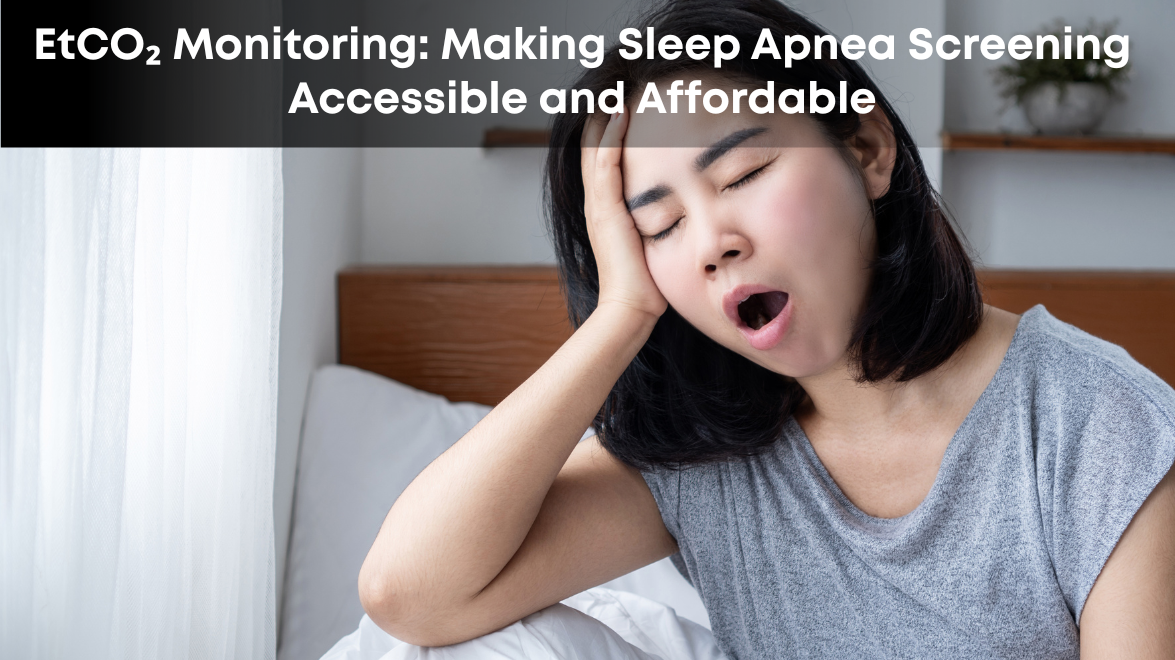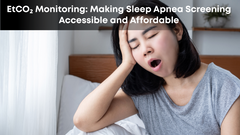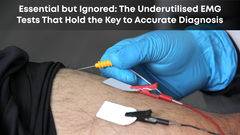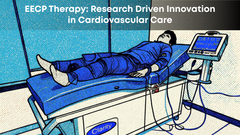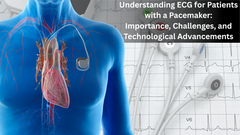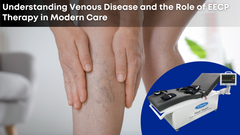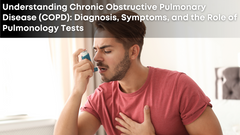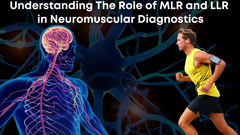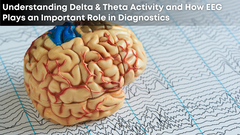EtCO₂ Monitoring: Making Sleep Apnea Screening Accessible and Affordable
Sleep apnea is a condition that has long gone underdiagnosed. Millions of people struggle with disrupted sleep, chronic fatigue, and serious health risks, yet the underlying cause often remains hidden. Traditionally, diagnosing sleep apnea requires overnight polysomnography (PSG) in a sleep laboratory—a process that is expensive, time-consuming, and inconvenient for patients.
But a shift is happening in respiratory diagnostics. EtCO₂ (End-Tidal Carbon Dioxide) monitoring, once reserved for anaesthesia and critical care, is now emerging as a practical and non-invasive screening tool for conditions like sleep apnea. With modern portable monitors integrating EtCO₂ sensors, early detection of breathing irregularities is becoming more accessible than ever.
This blog explores how EtCO₂ monitoring can transform sleep apnea screening, its clinical significance, and how Clarity Medical’s innovation is paving the way for simplified, accurate, and cost-effective respiratory diagnostics.
Understanding Sleep Apnea and the Diagnostic Gap
Sleep apnea is characterised by pauses in breathing or shallow breaths during sleep, leading to reduced oxygen intake and fragmented sleep cycles. The two most common forms are:
- > Obstructive Sleep Apnea (OSA): Airway blockage due to relaxed throat muscles.
- > Central Sleep Apnea (CSA): The Brain fails to send proper signals to the breathing muscles.
The global prevalence of sleep apnea is estimated at 1 billion people, yet most remain undiagnosed. Left untreated, sleep apnea contributes to:
- > Hypertension and cardiovascular disease
- > Increased risk of stroke and diabetes
- > Daytime fatigue and reduced productivity
- > Higher risk of accidents due to drowsiness
The diagnostic gold standard—polysomnography (PSG)—requires overnight monitoring in a specialised sleep lab. While accurate, it is resource-heavy and often inaccessible, especially in regions with limited infrastructure. This creates a pressing need for portable, non-invasive, and affordable screening methods.
The Role of EtCO₂ Monitoring in Respiratory Assessment
EtCO₂ monitoring measures the concentration of carbon dioxide at the end of exhalation. This value directly reflects alveolar ventilation and provides real-time insights into respiratory function.
In clinical practice, EtCO₂ is already used for:
- > Confirming proper endotracheal tube placement
- > Monitoring sedation or anaesthesia depth
- > Assessing ventilator performance in ICUs
- > Evaluating respiratory depression in emergency settings
When applied to sleep apnea screening, EtCO₂ adds a powerful dimension: it tracks ventilation changes during sleep, detecting hypoventilation, apnea episodes, and irregular breathing patterns with high sensitivity.
Why EtCO₂ Monitoring is Effective in Sleep Apnea Screening
Unlike pulse oximetry (SpO₂), which reflects oxygen saturation in the blood, EtCO₂ provides a direct measurement of ventilation. This distinction is critical:
-
> Early Detection of Hypoventilation
Oxygen saturation may remain normal for several minutes even during partial airway obstruction. EtCO₂, however, identifies ventilation decline instantly, flagging apnea episodes before oxygen levels drop. -
> Non-Invasive and Patient-Friendly
EtCO₂ monitoring can be performed using a simple nasal cannula with an integrated sensor—much less invasive than full PSG setups. -
> Continuous and Real-Time Monitoring
Overnight EtCO₂ trends can show frequency, duration, and severity of apnea events, providing a clear clinical picture. -
> Cost-Effective and Scalable
Portable EtCO₂-enabled monitors reduce dependency on expensive sleep lab studies, making mass screening feasible in hospitals, clinics, and even home care.
EtCO₂ vs. Traditional Polysomnography
|
Parameter |
Polysomnography (PSG) |
EtCO₂ Monitoring |
|
Scope |
Tracks multiple physiological parameters (EEG, ECG, SpO₂, airflow, muscle activity) |
Focuses on ventilation and respiratory gas exchange |
|
Accuracy |
Gold standard for diagnosis |
Excellent screening tool, useful in triage and follow-up |
|
Cost |
High, requires specialized labs |
Lower, portable, scalable |
|
Patient Comfort |
Restrictive setup with multiple electrodes and wires |
Lightweight cannula, easy to tolerate |
|
Use Case |
Confirmatory diagnosis |
Screening, triage, long-term monitoring |
EtCO₂ does not replace PSG but bridges the diagnostic gap by identifying high-risk individuals who should undergo confirmatory testing.
Clinical Applications of EtCO₂ in Sleep Apnea
> Screening in Primary Care and Community Clinics
Physicians can quickly screen patients with suspected sleep apnea using EtCO₂ monitors during short sleep or nap studies.
> Home-Based Screening Programs
With portable EtCO₂-enabled monitors, patients can undergo overnight testing in their homes, reducing barriers to diagnosis.
> Follow-Up and Therapy Monitoring
EtCO₂ helps track patients on CPAP (Continuous Positive Airway Pressure) therapy, ensuring adherence and effectiveness.
> Screening High-Risk Groups
Obese patients, individuals with cardiovascular disease, or those undergoing preoperative assessments can be screened proactively.
Clarity Medical’s Innovation in EtCO₂ Monitoring
Clarity Medical has pioneered the development of India’s own EtCO₂ probes and monitoring solutions, designed to deliver high accuracy at affordable costs. Integrated into Recobro portable patient monitors, Clarity’s EtCO₂ technology is:
- > Portable and Lightweight – Ideal for use in hospitals, ambulances, and home environments.
- > Multi-Parameter Ready – Combines EtCO₂ with ECG, SpO₂, NIBP, IBP, temperature, and HR in a single device.
- > Telemonitoring Enabled – Allows real-time remote viewing of patient respiratory patterns, a critical feature for sleep apnea screening programs in rural and underserved areas.
- > Cost-Effective – Locally developed EtCO₂ probes reduce dependency on expensive imports, making widespread deployment possible.
This innovation not only enhances clinical capability but also promotes healthcare accessibility in developing regions.
Looking Ahead: The Future of Sleep Apnea Screening
As healthcare shifts toward early diagnosis and preventive care, EtCO₂ monitoring is positioned to become a standard screening tool. Simplifying respiratory assessment, enables healthcare providers to:
- > Identify at-risk patients earlier
- > Reduce healthcare costs by avoiding complications
- > Improve patient compliance with simpler tests
- > Expand sleep apnea care beyond specialized sleep labs
With integration into portable monitors and telehealth systems, the future may see nationwide screening programs for sleep apnea leveraging EtCO₂—making diagnosis faster, more inclusive, and more reliable.
Conclusion
Sleep apnea is a silent but serious condition that requires wider awareness and easier access to screening. While polysomnography remains the diagnostic gold standard, EtCO₂ monitoring offers a practical, non-invasive, and cost-effective alternative for large-scale screening and follow-up.
Clarity Medical’s commitment to developing indigenous EtCO₂ probes and portable monitoring solutions ensures that this powerful technology is not limited to advanced hospitals but reaches communities and clinics where it is needed most.
By embracing EtCO₂ monitoring, healthcare providers can take a proactive step in tackling sleep apnea—transforming patient outcomes through early detection, effective monitoring, and timely intervention.


